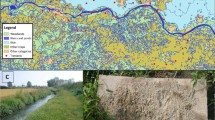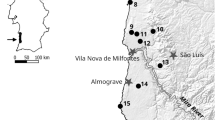Abstract
We propose a new reconnaissance method for mouse-sized mammal abundance estimation that does not involve animal capture. For survey purposes, we used plastic bottles without covers, which were baited and set out with free entry and exit for animals. Two patterns of setting out were tested: 5 and 10 m intervals on transects of 120 m in length. The total abundance of small mammals was estimated by the proportion of bottles in which baits were absent or eaten. These values were compared with data obtained in the same places by means of snap-trap lines or live-trap plots. We determined empirical coefficients for the conversion of the bottle attendance index into relative numbers (individuals per 100 trap nights) or community density (individuals per ha). It was shown that the method can be used in urban environments and combines quantitative estimation with low labour expenditures and high simplicity.




Similar content being viewed by others
REFERENCES
Harris, D.B., Gregory, S.D., and Macdonald, D.W., Space invaders? A search for patterns underlying the coexistence of alien black rats and Galápagos rice rats, Oecologia, 2006, vol. 149, pp. 27–288. https://doi.org/10.1007/s00442-006-0447-7
Khlyap, L.A. and Warshavskiy, A.A., Synanthropic and agrophilic rodents as invasive alien mammals, Russ. J. Biol. Invasions, 2010, no. 3, pp. 73–91.
Walker, S., Kemp, J.R., Elliott, G.P., Mosen, C.C., and Innes, J.G., Spatial patterns and drivers of invasive rodent dynamics in New Zealand forests, Biol. Invasions, 2019, vol. 21, no. 5, pp. 1627–1642. https://doi.org/10.1007/s10530-019-01922-0
Ward, S., Fournier, A.M., and Bond, A.L., Assessing gaps in reporting non-target mortality in island rodent eradication operations, Biol. Invasions, 2019, vol. 21, no. 10, pp. 3101–3108. https://doi.org/10.1007/s10530-019-02032-7
Denomme-Brown, S.T., Cottenie, K., Falls, J.B., Falls, E.A., Brooks, R.J., and McAdam, A.G., Variation in space and time: A long-term examination of density-dependent dispersal in a woodland rodent, Oecologia, 2020, vol. 193, pp. 903–912. https://doi.org/10.1007/s00442-020-04728-3
Shchipanov, N.A., Population resilience of small mammals. Why it is important and what it depends on?, Povolzh. J. Ecol., 2019, no. 4, pp. 503–523. https://doi.org/10.35885/1684-7318-2019-4-503-523
Johnson, B.W., Preliminary experimental studies of mice of Mount Desert Island, Maine, J. Mammal., 1927, vol. 8, no. 4, pp. 276–284. https://doi.org/10.2307/137332
Middleton, A.D., Cycles in the numbers of British voles (Microtus), J. Ecol., 1930, vol. 18, no. 1, pp. 156–165. https://doi.org/10.2307/2255899
Dice, L.R., Methods of indicating the abundance of mammals, J. Mammal., 1931, vol. 12, no. 4, pp. 376–381. https://doi.org/10.2307/1373764
Elton, C., Ford, E.B., and Baker, J.R., The health and parasites of a wild mouse population, Proc. Zool. Soc. Lond., 1931, vol. 101, no. 3, pp. 657–721. https://doi.org/10.1111/j.1096-3642.1931.tb01037.x
Clarin, B.M., Bitzilekis, E., Siemers, B.M., and Goerlitz, H.R., Personal messages reduce vandalism and theft of unattended scientific equipment, Methods Ecol. Evol., 2014, no. 4, pp. 125–131. https://doi.org/10.1111/2041-210X.12132
Sheftel, B.I., Methods for estimating the abundance of small mammals, Russ. J. Ecosyst. Ecol., 2018, vol. 3, no. 3, pp. 1–21. https://doi.org/10.21685/2500-0578-2018-3-4
Hamm, K.A. Diller, L.V., and Kitchen D.W., Comparison of indices to estimate abundance of dusky-footed woodrats, Wildlife Soc. Bull., 2002, vol. 30, no. 1, pp. 64–70.
Aplin, K.P., Brown, P.R., Jacob, J., Krebs, C.J., and Singleton, G.R., Field Methods for Rodent Studies in Asia and the Indo-Pacific, ACIAR Monogr. no. 100, Canberra: Australia, 2003. https://aciar.gov.au/sites/ default/files/legacy/node/528/mn100field_methods_ for_rodent_studies_in_asia_and__19800.pdf.
Karaseva, E.V., Telitsina, A.Yu., and Zhigalsky, O.A., et al., The Methods of Studying Rodents in the Wild Nature, Moscow: IKI, 2008.
Bean, W.T., Stafford, R., Prugh, L.R., Butterfield, H.S., and Brashares, J.S., An evaluation of monitoring methods for the endangered giant kangaroo rat, Wildlife Soc. Bull., 2012, vol. 36, pp. 587–593. https://doi.org/10.1002/wsb.171
Blackwell, G.L., Potter, M.A., and McLennan, J.A., Rodent density indices from tracking tunnels, snap-traps and Fenn traps: Do they tell the same story?, N. Z. J. Ecol., 2002, vol. 26, no. 1, pp. 43–51. https://pdfs.semanticscholar.org/352b/bbb64654cfd287fdc8d52d07de9bb3dd0bc2.pdf.
Nams, V.O. and Gillis, E.A., Changes in tracking tube use by small mammals over time, J Mammal., 2003, vol. 84, no. 4, pp. 1374–1380. https://doi.org/10.1644/BEH-001
De Bondi, N., White, J.G., Stevens, M., and Cooke, R., A comparison of the effectiveness of camera trapping and live trapping for sampling terrestrial small-mammal communities, Wildlife Res., 2010, vol. 37, pp. 456–465. https://doi.org/10.1071/WR10046
Torre, I., Arrizabalaga, A., Freixasa, L., Ribas, A., Flaquer, C., and Diazc, M., Using scats of a generalist carnivore as a tool to monitor small mammal communities in Mediterranean habitats, Basic Appl. Ecol., 2013, vol. 14, no. 2, pp. 155–164. https://doi.org/10.1016/j.baae.2013.01.005
Hacker, K.P., Minter, A., Begon, M., et al., A comparative assessment of track plates to quantify fine scale variations in the relative abundance of Norway rats in urban slums, Urban Ecosyst., 2016, vol. 19, pp. 561–575. https://doi.org/10.1007/s11252-015-0519-8
Jones, J.P.G., Monitoring species abundance and distribution at the landscape scale, J. Appl. Ecol., 2011, vol. 48, pp. 9–13. https://doi.org/10.1111/j.1365-2664.2010.01917.x
Luque-Larena, J.J., Mougeot, F., Vinuela, J., Jareno, D., Arroyo, L., Lambin, X., and Arroyo, B., Recent large-scale range expansion and outbreaks of the common vole (Microtus arvalis) in NW Spain, Basic Appl. Ecol., 2013, vol. 14, no. 5, pp. 432–441. https://doi.org/10.1016/j.baae.2013.04.006
Morris, P.A. and Harper, J.F., The occurrence of small mammals in discarded bottles, J. Zool., 1965, vol. 145, no. 1, pp. 148–153. https://doi.org/10.1111/j.1469-7998.1965.tb02010.x
Benedict, R.A. and Billeter, M.C., Discarded bottles as a cause of mortality in small vertebrates, Southeast Nat., 2004, vol. 3, no. 2, pp. 371–377. https://doi.org/10.1656/058.014.0310
Arrizabalaga, A., Gonzalez, L.M., and Torre, I., Small mammals in discarded bottles: A new world record, Galemys, 2016, no. 28, pp. 63–65. https://doi.org/10.7325/Galemys.2016.N4
Torre, I., Jimenez, I., Ribas, A., and Arrizabalaga, A., The efficiency of discarded drink containers for small mammal detection on a Mediterranean Mountain, Mammal Study, 2019, vol. 44, no. 4, pp. 243–252. https://doi.org/10.3106/ms2019-0025
Collett, D., Modelling Binary Data, 2nd ed., Boca Raton, FL: Chapman and Hall, 2002.
Warton, D.I. and Hui, F.K.C., The arcsine is asinine: The analysis of proportions in ecology, Ecology, 2011, no. 92, pp. 3–10. https://doi.org/10.1890/10-0340.1
Dice, L.R. and Howard, W.E., Distance of dispersal by prairie deermice from birthplaces to breeding sites, Contributions from the Laboratory of Vertebrate Biology, Univ. of Michigan, 1951, no. 50, pp. 1–15.
Andrzejewski, R., Babińska-Werka, J., Liro, A., Owadowska, E., and Szacki, J., Homing and space activity in bank voles, Clethrionomys glareolus, Acta Theriol., 2000, vol. 45, no. 2, pp. 155–165. http://rcin.org.pl/Content/ 13001/BI002_2613_Cz-40-2_Acta-T44-nr17-153-165_ o.pdf.
Jareno, D., Vinuela, J., Luque-Larena, J.J., Arroyo, L., Arroyo, B., and Mougeot, F., A comparison of methods for estimating common vole (Microtus arvalis) abundance in agricultural habitats, Ecol. Indic., 2014, vol. 36, pp. 111–119.
Torre, I., Raspalla, A., Arrizabalagaa, A., and Diazc, M., Evaluating trap performance and volunteers’ experience in small mammal monitoring programs based on citizen science: The SEMICE case study, Mammal. Biol., 2019, vol. 95, pp. 26–30. https://doi.org/10.1016/j.mambio.2019.01.004
Do, R., Shonfield, J., and Mcadam, A.G., Reducing accidental shrew mortality associated with small-mammal livetrapping: 2. A feld experiment with bait supplementation, J. Mammal., 2013, vol. 94, no. 4, pp. 754–760. https://doi.org/10.1644/12-MAMM-A-242.1
Churchfield, S., Barber, J., and Quinn, C., A new survey method for water shrews (Neomys fodiens) using baited tubes, Mammal Rev., 2000, vol. 30, pp. 249–254. https://doi.org/10.1046/j.1365-2907.2000.00074.x
Sweetapple, P. and Nugent, G., Chew-track-cards: A multiple-species small mammal detection device, N. Z. J. Ecol., 2011, vol. 35, no. 2, pp. 153–162. https://newzealandecology.org/system/files/articles/NZJEcol35_2_ 153.pdf.
Smirnov, V.S. and Bakhmutov, V.A., Census of murid rodents under conditions of long-term observations, in Biologicheskie osnovy ispol’zovaniya prirody severa (Biological Bases of Nature Resource Use in the North), Syktyvkar: Komi Knizhn. Izd., 1970, pp. 206–212.
Pearson, D.E. and Ruggiero, L.F., Transect versus grid trapping arrangements for sampling small-mammal communities, Wildl. Soc. Bill., 2003, vol. 31, no. 2, pp. 454–459. www.jstor.org/stable/3784324.
Lambin, X., Elston, D.A., and Petty, S.J., MacKinnon J.L., Spatial asynchrony and periodic travelling waves in cyclic populations of field voles, Proc. R. Soc. Lond. B, 1998, vol. 265, no. 1405, pp. 1491–1496. https://doi.org/10.1098/rspb.1998.0462
Sikes, R.S. and Gannon, W.L., and the Animal Care and Use Committee of the American Society of Mammalogists, Guidelines of the American Society of Mammalogists for the use of wild mammals in research, J Mammal., 2011, vol. 92, no. 1, pp. 235–253. https://doi.org/10.1644/10-MAMM-F-355.1
ACKNOWLEDGMENTS
The authors are grateful to the administration of the Botanical Garden of the Ural Branch of the Russian Academy of Sciences for permission to work in the arboretum. The authors are grateful to PhD Ivan Kshnyasev for useful advice on the statistical processing of the material and to Irina Tolkacheva for photo of traps.
Funding
This study was performed within the frameworks of state contract with the Institute of Plant and Animal Ecology, Ural Branch, Russian Academy of Sciences and partly supported by the Russian Foundation for Fundamental Investigations, grant no. 20-04-00164a.
Author information
Authors and Affiliations
Corresponding author
Ethics declarations
All sampling methods used in this study are in accordance with current ethical standards [40]. All field methods were approved by the Bioethics commission of the Institute of Plant and Animal Ecology, Ural Branch, Russian Academy of Sciences (protocol #001/2020). It is important to note that snap trapping is not an essential part of the bottle-line method. In this study, such an approach was needed only to test and calibrate the methodology.
Rights and permissions
About this article
Cite this article
Tolkachev, O.V., Malkova, E.A. & Maklakov, K.V. A Reconnaissance Method for Small Mammal Abundance Assessment in Urban Environments. Russ J Ecol 52, 329–339 (2021). https://doi.org/10.1134/S106741362104010X
Received:
Revised:
Accepted:
Published:
Issue Date:
DOI: https://doi.org/10.1134/S106741362104010X




